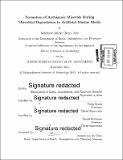Formation of authigenic minerals during microbial degradation in artificial marine media
Author(s)
Joss, Matthew Albert Henry
DownloadFull printable version (7.235Mb)
Other Contributors
Massachusetts Institute of Technology. Department of Earth, Atmospheric, and Planetary Sciences.
Advisor
Tanja Bosak and Daniel Rothman.
Terms of use
Metadata
Show full item recordAbstract
I have conducted incubation experiments exploring microbial degradation of organic matter within an artificial sediment designed to simulate an organic-rich siliciclastic marine sediment. Central questions to my research include: 1) How does the presence of dissolved iron influence the degradation and/or protection of organic matter within sediments? 2) How does dissolved iron influence the development of authigenic minerals? 3) How do microbial metabolisms affect dissolved iron concentrations and authigenic mineral precipitation? My experimental system consisted of dead cyanobacterial cells that were mixed with acid-washed glass beads, thereby making an artificial sediment essentially free of contaminants. This material was deposited into incubation cultures with artificial marine liquid media with varying concentrations of dissolved Fe(III). The cultures were exposed either to a natural sediment community or to the iron-reducing facultative anaerobe Shewanella Putrefaciens, in oxia or in anoxia. These cultures were compared against controls that contained no living microbes. The liquid media had varying initial concentrations of dissolved iron. For cultures with initially 0.2 mg/L of dissolved Fe(III) or no initial dissolved Fe(III), I measure the extent of degradation through loss on ignition gravimetry after 40 days of incubation. I also measured pH levels, dissolved Fe(II), and total Fe over a period of 60 days. Scanning electron microscopy and energy dispersive X-ray spectroscopy were used to identify mineralized organic particles and mineral grains within subsamples of the living cultures. In contrast, the sterile controls had no recognizable mineralization present. Finally, X-ray diffraction spectra were obtained for sediment subsamples of cultures with initial iron concentrations of 0.1 mg/L, revealing spectral peaks indicative of small amounts of authigenic mineral structure present within the oxic living cultures. Iron is identified as a key component of many mineralized structures within the living samples, particularly in the anoxic samples, with iron rich particles usually being mostly amorphous. It is possible that longer incubation times would increase the extent of mineralization and produce divergent rates of organic matter protection and degradation.
Description
Thesis: S.M. in Geobiology, Massachusetts Institute of Technology, Department of Earth, Atmospheric, and Planetary Sciences, 2015. Cataloged from PDF version of thesis. Includes bibliographical references (pages 73-74).
Date issued
2015Department
Massachusetts Institute of Technology. Department of Earth, Atmospheric, and Planetary SciencesPublisher
Massachusetts Institute of Technology
Keywords
Earth, Atmospheric, and Planetary Sciences.